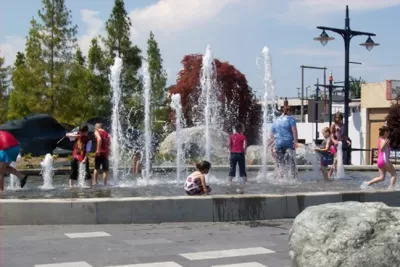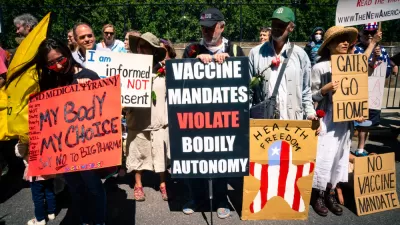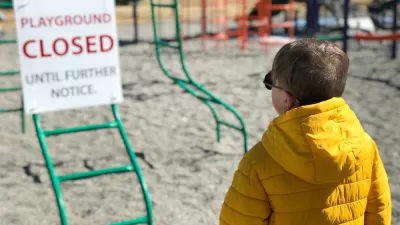The "Using Behavioral Economics to Create Playable Cities" report suggests that so much time spent in front of screens, and the continued need to counter the obesity epidemic, requires new thinking about play for children living in cities.

Rachel Dovey shares news of a report by KaBOOM about how to build "playable cities" [pdf]. The idea is presented as an alternative to traditional play areas, which are lacking or underutilized in many places.
Here's how Dovey describes the idea put forward by the report: "Instead of setting spaces aside for play, why not integrate them into the streets, sidewalks and bus stops people use every day? If the park isn’t a destination — if it’s a bus stop in the shape of the word BUS that kids can lounge, jump and slide on — then they end up playing during their daily commute. And quick-access structures integrated into city streets could both keep families from leaving for the suburbs and encourage them to bike, walk and take the bus instead of driving cars."
To make that argument, the report "delves into some of the psychological barriers that can also limit access, using a lens called 'behavioral economics' to see 'how people make decisions in a complex and textured world where details matter.'"
FULL STORY: For Family-Friendly Cities, Build Play Beyond the Playground

Study: Maui’s Plan to Convert Vacation Rentals to Long-Term Housing Could Cause Nearly $1 Billion Economic Loss
The plan would reduce visitor accommodation by 25,% resulting in 1,900 jobs lost.

Alabama: Trump Terminates Settlements for Black Communities Harmed By Raw Sewage
Trump deemed the landmark civil rights agreement “illegal DEI and environmental justice policy.”

Why Should We Subsidize Public Transportation?
Many public transit agencies face financial stress due to rising costs, declining fare revenue, and declining subsidies. Transit advocates must provide a strong business case for increasing public transit funding.

Paris Bike Boom Leads to Steep Drop in Air Pollution
The French city’s air quality has improved dramatically in the past 20 years, coinciding with a growth in cycling.

Why Housing Costs More to Build in California Than in Texas
Hard costs like labor and materials combined with ‘soft’ costs such as permitting make building in the San Francisco Bay Area almost three times as costly as in Texas cities.

San Diego County Sees a Rise in Urban Coyotes
San Diego County experiences a rise in urban coyotes, as sightings become prevalent throughout its urban neighbourhoods and surrounding areas.
Urban Design for Planners 1: Software Tools
This six-course series explores essential urban design concepts using open source software and equips planners with the tools they need to participate fully in the urban design process.
Planning for Universal Design
Learn the tools for implementing Universal Design in planning regulations.
Smith Gee Studio
Alamo Area Metropolitan Planning Organization
City of Santa Clarita
Institute for Housing and Urban Development Studies (IHS)
City of Grandview
Harvard GSD Executive Education
Toledo-Lucas County Plan Commissions
Salt Lake City
NYU Wagner Graduate School of Public Service




























